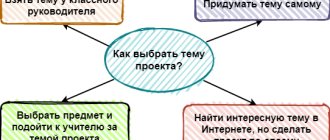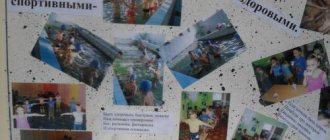Before starting to compile and write notes for an assignment in kindergarten, the teacher must:
- select the type of lesson;
- think over the structure;
- choose a rational form of training;
- think over the beginning of the lesson, its course and end;
- select the required number of games and activities;
- select didactic material;
- format the title page correctly.
Particular attention should be paid to the title page. Even if you looked at an example or sample, filling out the title page can still cause some difficulties.
If you also have questions about how to correctly format the title page of an assignment summary in kindergarten, then these recommendations will help you cope with this task 100%.
How to design a title page for an open lesson at a preschool educational institution
The title page of the summary of the assignment in kindergarten is drawn up in accordance with the requirements of the Federal State Educational Standard. It must reflect all input data:
- at the top of the title page the full name and name of the preschool institution is indicated;
- in the center of the sheet you must add the inscription: “Outline of continuous educational activities in ... (instead of an ellipsis, you must indicate a specific area);
- then indicate the name of the topic and age group;
- below you need to write the title of the abstract;
- in the lower right corner it is indicated who wrote the notes. The surname and initials of the author, his position, qualifications and category are indicated;
- The next item is the date of the lesson. It can be registered in two ways: November 16, 2021 or November 16, 2021;
- at the bottom of the title page, in the center, the city is indicated, and even lower, the year when the summary was written.
We will help with distance learning
Submit a request for a free cost estimate
Algorithm for preparing a GCD outline in accordance with the Federal State Educational Standard DO Article on the topic
Kozarenko E.S., teacher
GBDOU kindergarten No. 53, Kolpinsky district
St. Petersburg
Algorithm for preparing a GCD outline in accordance with the Federal State Educational Standard for Educational Education
Some teachers have difficulty preparing GCD notes. Let's remember how this is done. Let's start with the title page.
The full name of the preschool institution is indicated at the top of the title page. Approximately in the middle of the sheet there is an inscription: Synopsis of direct educational activities in (Area) on the topic: “………………..” for children of senior preschool age. Below the title of the abstract, on the right, the surname, initials of the author and his position, group number are indicated. At the bottom of the title page, in the middle, the city is written, and even lower, the year when the summary was written.
The next sheet begins with the gcd goal. What is a goal?
The goal is the end result, what we strive for. It is recommended that the goal be determined by a noun from a verb: creating conditions, forming, educating, strengthening, etc.
And tasks are formed by verbs in an indefinite form: create, strengthen, educate, implement, etc.
The purpose and objectives of the lesson replace the program content.
I would like to draw your attention to an interesting nuance: many teachers write the word “educational” instead of the word “educational”, meaning only educational tasks. But the concept of “education” (read the law “On Education in the Russian Federation”) includes both training and upbringing. This means that educational tasks will involve both teaching and educational tasks together. In this case, you will have 2 groups of tasks: developmental and educational.
A task is something that requires execution or solution. Tasks in relation to the goal are and are: 1. Educational tasks (it is written what we will teach children in this lesson). Do not write the verb “teach” in the tasks! It is more correct to write “to promote”, “to form skills”, “to create conditions”, “to develop”, etc.
2. Developmental tasks (it is written that we will consolidate, clarify, not forgetting the development of mental functions and various properties).3. Educational tasks (what mental, aesthetic, moral and volitional qualities will be formed in this lesson). It should be remembered that each new task is written on a new line. When the tasks are formulated, it is necessary to indicate what preliminary work was carried out with children, the entire scope of frontal and individual work with children (Conversations with children, observation, reading fiction, where they went on an excursion, what they learned, etc.)
The forms of organizing collective activities are indicated (work in subgroups, in pairs, joint activities of the teacher with children) and independent activities of children (if planned).
Methods and techniques: Playful, visual, practical activities for children, questions for children, verbal, didactic games, use of fiction, vocabulary work or vocabulary activation; individual work; differentiated approach, parental participation in educational activities (if applicable).
Materials and equipment: lists what equipment will be used at this GCD (for example: tape recorder, flannelograph, easel, wall board, cubes, stands, etc.). Next, the demonstration material is indicated, which lists not only all the manuals and paintings, but also their authors, quantity, and sizes. When describing handouts, it is necessary to list what material is taken, indicating the size and quantity. The following describes the structure and methodological techniques used in the lesson. The parts of the lesson and specific methodological techniques are indicated. For example:I. Introductory part - 3 minutes. a) reading the poem “Autumn” by A.S. Pushkin; b) watching the autumn sky from the window; c) verbal didactic game “Come up with a word” (selection of adjectives for the words sky, autumn, foliage). II. The main part is 15 minutes. a) conversation about weather phenomena in autumn; b) looking at weather calendars; c) physical minute; d) writing stories about autumn weather; e) children naming autumn signs and sayings about autumn; f) didactic game “Which tree is the leaf from”... etc. III. The final part (reflective stage) - 2 minutes. a) generalization by the teacher; b) GCD analysis (about what knowledge the children showed). And finally, a description of the progress of the GCD begins. The GCD move is written in direct speech. Be sure to write down all the words that the teacher will say, the expected answers of the children, and the teacher’s generalizations. If during the lesson the teacher needs to perform some actions, this is indicated in the notes. For example: GCD move: 1. Reading the poem “Autumn” by A.S. Pushkin; Educator: “Children, if you want, I’ll read you a poem by A.S. Pushkin's "Autumn"? Children: “Yes, we want!” Educator: “October has already arrived - the grove is already shaking off the last leaves from its naked branches; The autumn chill has blown in - the road is freezing...” So further on all points of the GCD structure.
So, if we briefly describe all of the above, then the structure of the GCD summary is as follows: If there is a title page, then the second page begins with the Objective, if without a title page, then it looks like this:
Topic: “Snowflakes outside the window” (Times New Roman 16) (Secondary group No. 1, Ivanov I.I.) (Times New Roman 14) Educational area: Artistic and aesthetic development Goal: Objectives: Educational: Developmental: Educational: Preliminary work: Methods and techniques: Materials and equipment: GCD structure: I. Introductory part: II. Main part: III. Final part: GCD move:
Sample title page for lesson notes in kindergarten
MAGAZINE Preschooler.RF
Methodological recommendations for educators “How to correctly prepare a GCD outline in accordance with the Federal State Educational Standard for Educational Education”Some teachers have difficulty preparing GCD notes. Let's remember how this is done. Let's start with
title page.
The full name of the preschool institution is indicated at the top of the title page. Approximately in the middle of the sheet there is an inscription: Summary of direct educational activities in (Area) on the topic: “” for children of senior preschool age.
Below the title of the abstract, on the right, the surname, initials of the author and his position, group number are indicated.
At the bottom of the title page, in the middle, the city is written, and even lower, the year when the summary was written.
The next sheet begins with the gcd goal. What is a goal? The goal is the end result, what we strive for. It is recommended that the goal be determined by a noun from a verb: creating conditions, forming, educating, strengthening, etc. And tasks are formed by verbs in an indefinite form: create, strengthen, educate, implement, etc. The goals and objectives of the lesson replace the program content.
A task is something that requires execution or solution. Tasks in relation to the goal are and are:
- Educational tasks (write what we will teach children in this lesson). Do not write the verb “teach” ! It is more correct to write “to promote” , “to form skills” , “to create conditions” , “to develop”, etc.
- Developmental tasks (it is written that we will consolidate, clarify, not forgetting the development of mental functions and various properties).
- Educational tasks (what mental, aesthetic, moral and volitional qualities will be formed in this lesson).
It should be remembered that each new task is written on a new line.
When the tasks are formulated, it is necessary to indicate what preliminary work was carried out with children, the entire scope of frontal and individual work with children (Conversations with children, observation, reading fiction, where they went on an excursion, what they learned, etc.)
Methods and techniques: Playful, visual, practical activities for children, questions for children, verbal, didactic games, use of fiction, etc.
Materials and equipment: Lists what equipment will be used at this GCD (for example: tape recorder, flannelograph, easel, wall board, cubes, stands, etc.). Next, the demonstration material is indicated, which lists not only all the manuals and paintings, but also their authors, quantity, and sizes.
When describing handouts, it is necessary to list what material is taken, indicating the size and quantity.
The following describes the structure and methodological techniques used in the lesson. The parts of the lesson and specific methodological techniques are indicated.
For example:
Introductory part - 3 minutes,
a) reading the poem “Autumn” by A.S. Pushkin;
b) watching the autumn sky from the window;
c) verbal didactic game “Come up with a word” (selection of adjectives for the words sky, autumn, foliage),
II. The main part is 15 minutes. ^
a) conversation about weather phenomena in autumn;
b) looking at weather calendars; ^
c) physical minute; ugh
d) writing stories about autumn weather;
e) children naming autumn signs and sayings about autumn;
f) didactic game “Which tree is the leaf from” ... etc.
III. Final part - 2 minutes,
a) generalization by the teacher;
b) GCD analysis (about what knowledge the children showed).
And finally, a description of the progress of the GCD begins.
The GCD move is written in direct speech. Be sure to write down all the words that the teacher will say, the expected answers of the children, and the teacher’s generalizations. If during the lesson the teacher needs to perform some actions, this is indicated in the notes.
For example:
GCD move:
Poem "Autumn"
1. Reading the poem “Autumn” by A.S. Pushkin;
Educator: “Children, would you like me to read you a poem by A.S.
Pushkin's "Autumn" ?
Children: “Yes, we want!”
Educator: “October has already arrived - the grove is already shaking off the last leaves from its naked branches;
The autumn chill has blown in - the road is freezing..."
So, further on all points of the GCD structure.
So, if we briefly describe all of the above, the structure of the GCD summary is as follows:
If there is a title page, then the second page begins with the Objective, if without a title page, then it looks like this:
Topic: “Snowflakes Outside the Window” (Times New Roman 16)
(Secondary group No. 1, Ivanov I.I.) (Times New Roman 14) Educational field: Artistic and aesthetic development Goal:
Tasks:
- Educational:
- Educational:
- Educational:
- Preliminary work:
- Methods and techniques:
- Materials and equipment:
GCD structure:
I. Introductory part:
II. Main part:
III. Final part:
GCD move:
| Next > |





